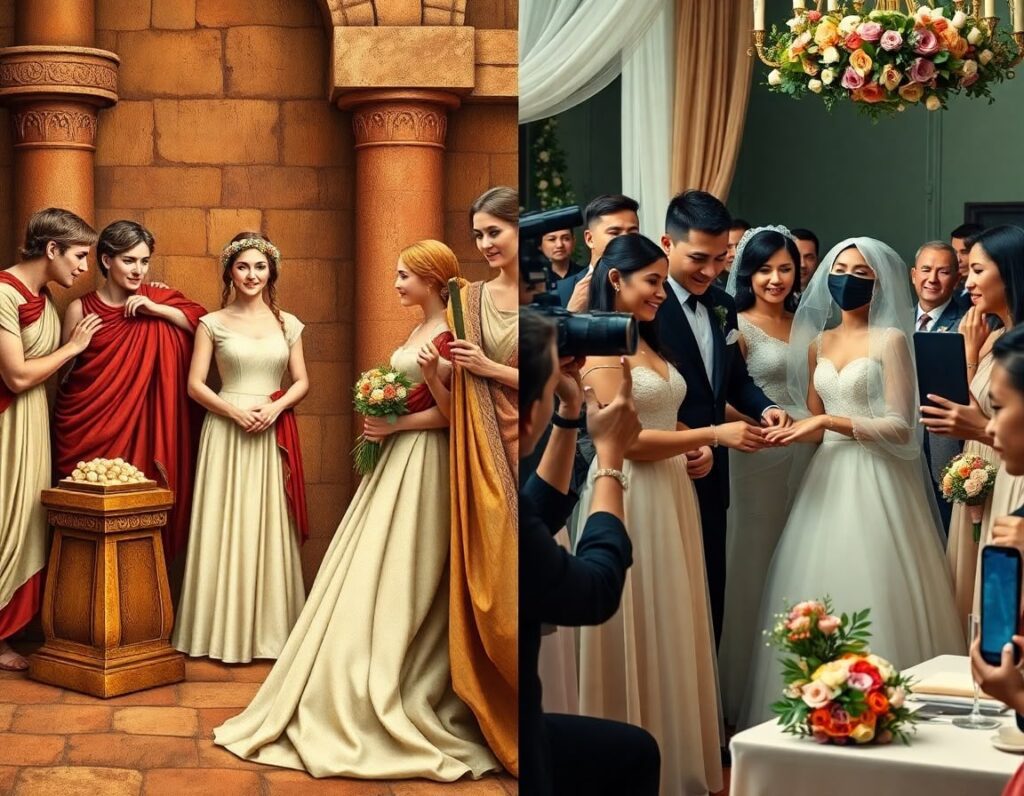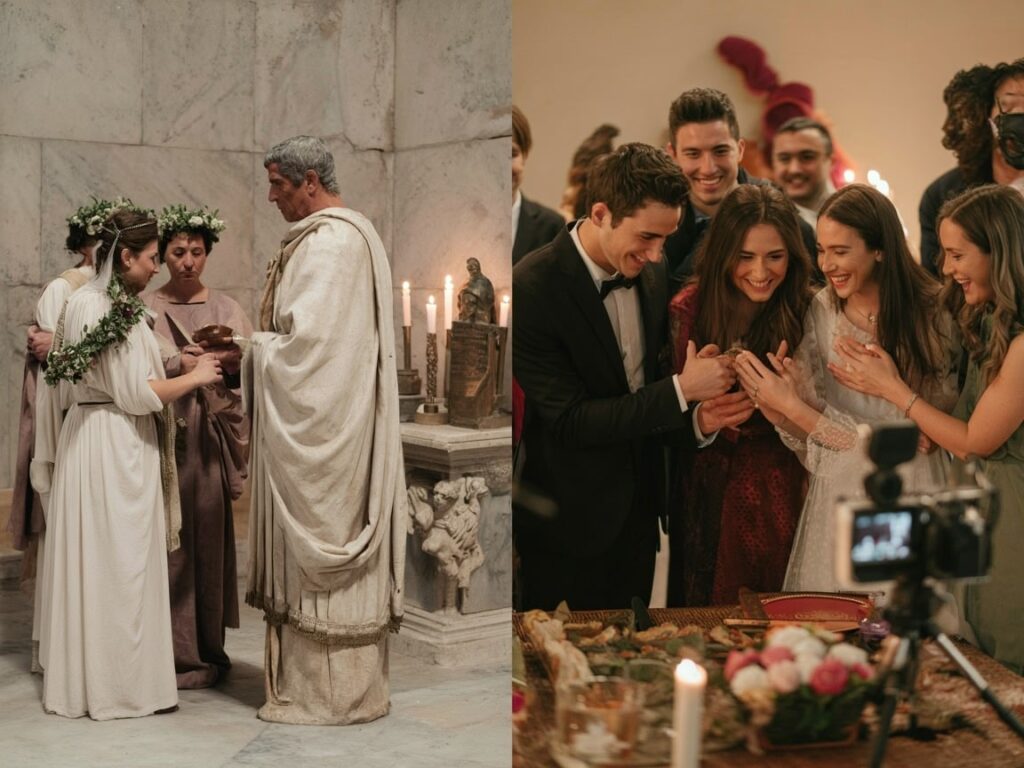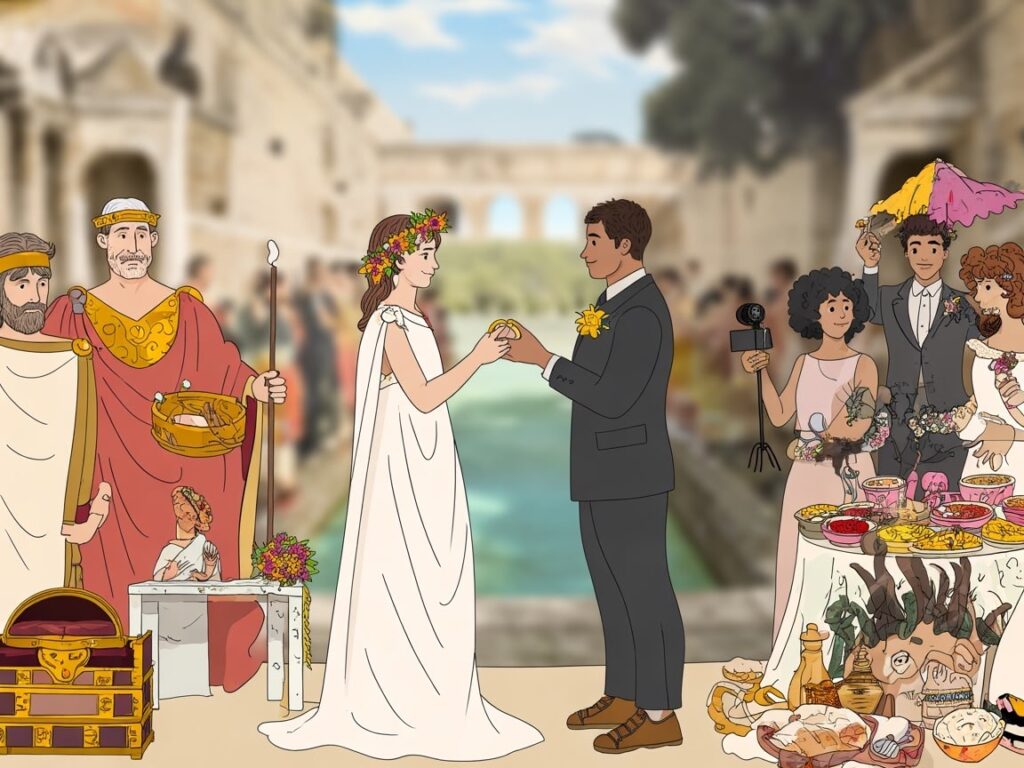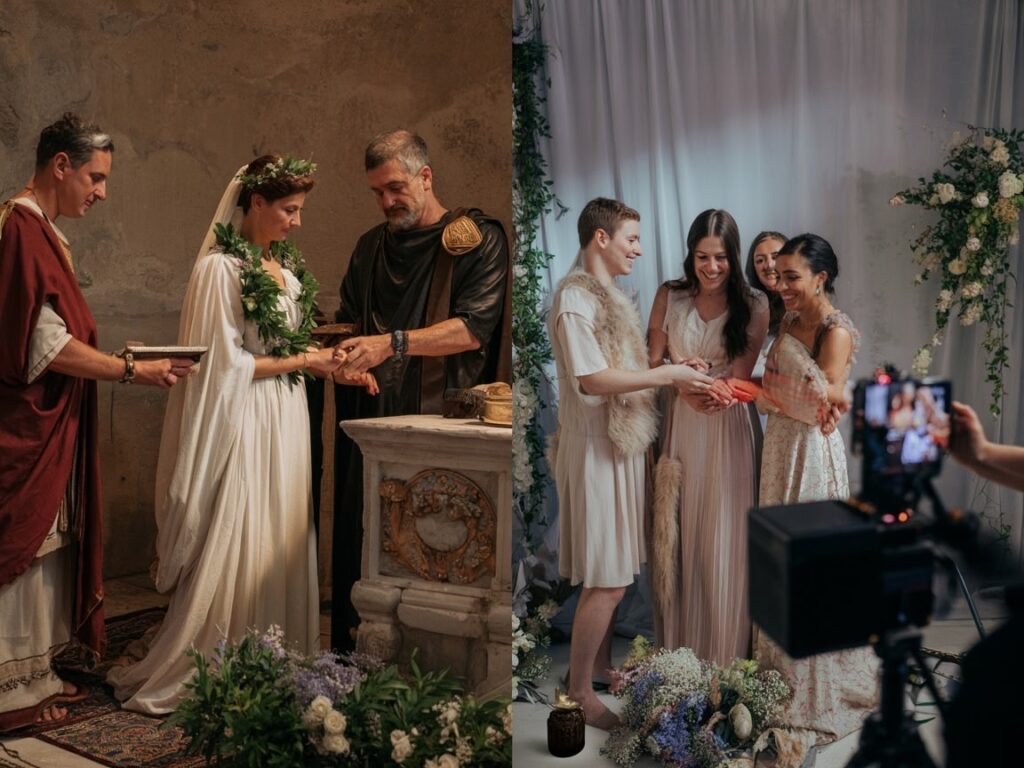Marriage traditions have been important in societies throughout history. They show us what a culture values, what social rules it follows, and how families are structured. Looking at how marriage customs have changed over time, from arranged marriages in ancient Rome to today’s focus on love matches, gives us an interesting insight into how human relationships have evolved.
Even though marriage customs have changed, some aspects of ancient Roman traditions can still be seen in modern weddings. This shows us how historical customs continue to influence present-day marriage practices. By exploring the journey from Rome to now, we can discover a rich tapestry of rituals and beliefs that still shape marriage in different ways today.
Ancient Roman Marriage Traditions
Marriage in ancient Rome was deeply embedded in social structure, largely controlled by the paterfamilias, the male head of the household. The paterfamilias held significant authority in arranging marriages, often prioritizing political alliances or family status over personal choice. His decisions shaped family dynamics, reinforcing patriarchal control and ensuring that marriages served broader social and economic goals.
The Role of Dowries
Dowries played a crucial role in these arrangements. The bride’s family provided a dowry, which was not merely a gift but a strategic asset influencing marital alliances. Dowries could enhance a family’s prestige or secure financial stability for the new household. They were often carefully negotiated and legally documented, reflecting their importance in Roman society.
Betrothal Customs and Symbolism
Betrothal customs carried rich symbolism. Engagements involved formal rituals such as the exchange of gifts—rings being the most notable—that signified promises and commitments between families and individuals. A kiss sealed the betrothal, marking a public acknowledgment of intent to marry. These practices underscored marriage as a contractual agreement with social obligations beyond personal affection.
Legal Regulations Governing Marriage
Roman law governed marriage through specific regulations:
- Minimum age: 12 for girls and 14 for boys.
- Consent: Both parties needed to agree, although parental approval, especially from the paterfamilias, was pivotal.
- Legal contracts formalized marriages to protect property rights and inheritance.
These legal frameworks ensured marriages were recognized officially while maintaining social order within Roman communities. This blend of family control, legal oversight, and ceremonial customs set the foundation for many enduring aspects of marriage traditions seen today.

Roman Wedding Ceremonies
In Roman wedding ceremonies, religious rituals played a significant role in invoking divine blessings for the newlyweds. Sacrifices were often made to Jupiter, the king of the gods, to ensure fertility and prosperity in the union. These offerings symbolized the couple’s reverence for the gods and their desire for a fruitful marriage.
Bridal attire carried deep symbolism during Roman weddings. The bride would don a white dress adorned with intricate details, signifying purity and innocence. Accessories like garlands of flowers and herbs were used not just for aesthetic purposes but also believed to ward off evil spirits. Fire played a crucial role in these ceremonies, with torches lit to purify the surroundings and protect against malevolent forces.
The bridal procession held immense significance in Roman culture, marking a symbolic transition from girlhood to womanhood. As the bride made her way from her family home to that of her husband, accompanied by loved ones and musicians, it represented her journey into a new phase of life. This procession underscored themes of continuity, change, and communal support as she embarked on this pivotal moment in her life.
Additionally, these ceremonies were rich in cultural significance and often reflected broader societal values. The various elements of the wedding, from the attire to the rituals performed, were steeped in tradition and served to reinforce social norms and expectations surrounding marriage in ancient Rome.

Gender Roles and Marriage in Ancient Rome
In ancient Rome, gender roles played a significant role in shaping marriage traditions:
1. Disparities in Adultery Consequences
Adultery consequences varied greatly between men and women in Roman society, reflecting societal attitudes towards fidelity. While adultery was punishable by death for wives, it was often tolerated for husbands, highlighting the unequal treatment based on gender.
2. Control of Divorce Proceedings
In ancient Rome, men held significant control over divorce proceedings, which had implications for women’s rights. Women had limited autonomy in deciding to end a marriage, as men predominantly dictated the terms of divorce. This power dynamic reinforced the patriarchal structure of Roman society and restricted women’s agency within marital relationships.
These gender roles and disparities in marital laws shed light on the societal norms and power dynamics prevalent in ancient Rome, influencing the evolution of marriage traditions over time. The status and rights of women during this period were significantly impacted by these gender roles. Furthermore, the legal aspects surrounding marriage and divorce in ancient Rome continue to influence modern marital laws in various cultures today.

Transition to Modern Marriage Traditions
In modern times, there has been a significant shift in the motivation behind marriages. While political alliances and economic considerations dictated marital unions in ancient Rome, contemporary marriages are predominantly driven by love. The concept of marrying for love has become a central tenet of modern relationships, emphasizing emotional connection and personal fulfillment over strategic advantages.
Alongside the transformation in marriage motivations, there has been a remarkable evolution in bridal attire. Bridal fashion has transitioned from symbolizing purity and modesty to showcasing personal style and individuality. Brides today have a myriad of options beyond traditional white gowns, with colorful dresses, unconventional designs, and unique accessories becoming increasingly popular. This shift reflects broader societal changes towards self-expression and breaking away from conventional norms in modern marriage traditions.
Modern Wedding Celebrations
Technology has transformed how couples celebrate their weddings. Live-streaming weddings became especially important during the COVID-19 pandemic, enabling friends and family to join virtually despite travel restrictions. This innovation continues to expand access, allowing participation across distances that were once barriers.
Inclusivity now shapes many wedding celebrations. Recognizing diverse marriages—including same-sex, intercultural, and non-traditional unions—has become standard practice. Roles within ceremonies reflect this shift, with partners sharing equal responsibilities and families blending customs to honor all identities present.
Personalization dominates modern receptions. Couples move beyond template formats to design experiences that showcase their personalities and stories. Examples include:
- Customized playlists instead of generic music selections
- Themed décor reflecting shared interests or cultural heritage
- Interactive activities such as guest art projects or storytelling circles
These trends make weddings unique expressions rather than mere formalities. They echo a broader cultural movement toward authenticity and individuality.
Technology, inclusivity, and personalization redefine what a wedding can be, creating celebrations that are both meaningful and memorable for everyone involved.

Core Elements from Ancient Rome in Modern Marriage Traditions
Many key elements found in The Evolution of Marriage Traditions from Rome to the Present Day reveal an impressive continuity that connects ancient ceremonies to modern weddings. These traditions have persisted because they resonate with fundamental human experiences—commitment, celebration, and community.
Exchange of Rings
- The practice of exchanging rings originated in ancient Rome, where a ring was given during betrothal as a symbol of promise and unity.
- Today, wedding rings remain one of the most recognizable symbols of marriage worldwide. The tradition of wearing the ring on the third finger of the left hand endures, rooted in the Roman belief that this finger contains the “vena amoris” or vein of love.
Bridal Parties
- Roman weddings featured attendants known as pronubae (bridesmaids) who had protective roles, guarding the bride against evil spirits.
- Modern bridal parties serve both practical and symbolic functions. Bridesmaids and groomsmen support the couple emotionally and logistically, maintaining social bonds that echo ancient communal values.
Processions
- The bridal procession was a central element in Roman weddings, marking the bride’s transition from her family to her husband’s household.
- Contemporary weddings often include processions that highlight the significance of entering a new phase of life. Whether walking down an aisle or parading through streets in cultural festivals, this ritual remains a powerful symbol of change and commitment.
Communal Feasting
- Feasting played a vital role in Roman marriage celebrations. It acted as a public affirmation of alliance between families and an occasion for social bonding.
- Modern weddings continue this tradition with receptions featuring shared meals, toasts, and dancing. These gatherings emphasize community support and joy surrounding the couple’s union.
These core rituals—rings, processions, bridal parties, feasting—anchor modern marriage traditions firmly within their ancient Roman heritage while adapting to contemporary values and lifestyles.

Conclusion
Looking back at the history of marriage traditions, from ancient Rome to now, it’s clear that some customs have stood the test of time and continue to influence modern practices.
When planning weddings today, it’s important to embrace both tradition and innovation. This means honoring the origins of ancient rituals while also adapting them to reflect personal values and beliefs.

